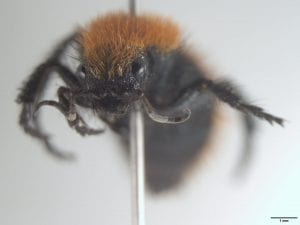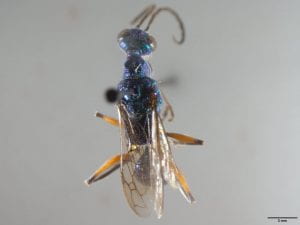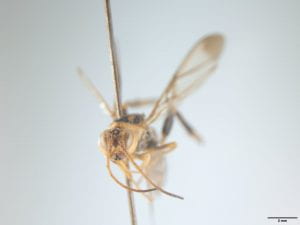
This week’s wasp is the velvet wasp species Dasymutilla vestita, a fuzzy little wasp of the family Mutillidae! This species was first described by Lepeletier in the year 1845.
Taxonomy: This species is a member of the superfamily “Vespoidea” and the family Mutillidae. The superfamily “Vespoidea” was, until recently, considered to be monophyletic with respect to other superfamilies, but recent phylogenetic analysis demonstrates that the superfamily Apoidea (bees and allies) originates within “Vespoidea”. As a result, the higher classification of “Vespoidea” is being reconsidered. Under newer taxonomic systems, Mutillidae is placed in a superfamily along with Myrmosidae, Pompilidae, and Sapygidae.
The family Mutillidae itself contains more than 7,000 living species, which are classified in six subfamilies and 230 genera.

There are around 500 species known from America north of Mexico. Members of this family are often called “velvet ants,” but they are not actually ants. As a result, they are now sometimes referred to as velvet wasps. This species is common throughout the western United States. Mutillidae exhibits high degrees of sexual dimorphism, meaning many males do not look like the females of their respective species. As a result, the taxonomy of the group is highly cluttered, and many described males and females need to be matched with their respective sex.
Identification: Many members of the family Mutillidae are easily recognized as velvet wasps by their general appearance – rather large ant-like insects covered in stiff hairs. Dasymutilla vestita matches this description rather well – note the bright red-orange hairs over most of the body. Most species have a so-called “felt line” of dense hairs along the second segment of the metasoma. Mutillid males are the only members of the family with wings – the females are all apterous, or without wings.

Natural History: Mutillid wasps are parasitoids of many insect groups, although many species attack other wasps and bees. Other hosts include flies, moths, beetles, and roaches. Winged adult males often function as pollinators, and are frequently spotted on flowers. This group is particularly notable because of their painful stings – th
ey’re widely considered one of the most painful insect stings, next to species like tarantula hawks (Pepsis sp.).
View This Species On:
BugGuide: https://bugguide.net/node/view/121428
iNaturalist: https://www.inaturalist.org/taxa/154504-Dasymutilla-vestita
References:
- Aguiar, A. P., Deans, A. R., Engel, M. S., Forshage, M., Huber, J. T., Jennings, J. T., … & Miko, I. (2013). Order Hymenoptera. In: Zhang, Z.-Q.(Ed.) Animal Biodiversity: An Outline of Higher-level Classification and Survey of Taxonomic Richness (Addenda 2013). Zootaxa, 3703(1), 51-62.
- Goulet, H., Huber, J. T. (1993). Hymenoptera of the world: An identification guide to families. Ottawa: Research Branch Agriculture Canada.



 Figure 1: Ibalia anceps female, lateral habitus
Figure 1: Ibalia anceps female, lateral habitus Figure 2: Ibalia anceps female, dorsal habitus
Figure 2: Ibalia anceps female, dorsal habitus Figure 3: Ibalia anceps female, anterior view
Figure 3: Ibalia anceps female, anterior view Figure 4: Ibalia anceps female, face
Figure 4: Ibalia anceps female, face Figure 5: Ibalia anceps forewing, indicating the radial cell (in red)
Figure 5: Ibalia anceps forewing, indicating the radial cell (in red)